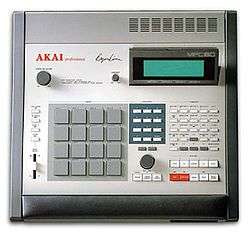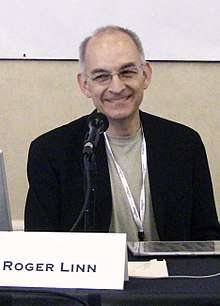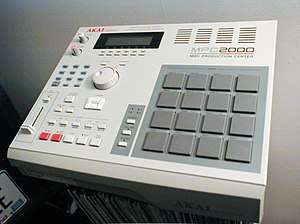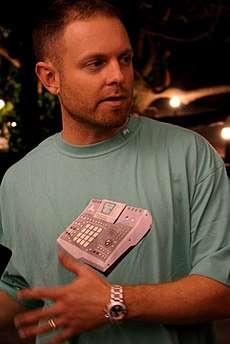Akai MPC
The Akai MPC (originally MIDI Production Center, now Music Production Center) is a series of music workstations produced by Akai from 1988 onwards. The MPC combines sampling and sequencing functions.
 An Akai MPC60, the first MPC model | |
| Electronic | |
|---|---|
| Other names | MIDI Production Center, Music Production Controller |
| Classification | |
| Inventor(s) | Roger Linn |
The first MPCs were designed by Roger Linn, who had designed the successful LM-1 and LinnDrum drum machines. He aimed to create an intuitive instrument, with a grid of pads that could be played similarly to a traditional instrument such as a keyboard or drum kit. Rhythms can be built not just from samples of percussion but samples of any sound, such as horns or synthesizers.
Linn anticipated that users would sample short sounds; to his surprise, they also sampled long sequences of music. The MPC had a major influence on the development of electronic and hip hop music, allowing musicians and producers to create elaborate tracks without a studio and opening the way for new sampling techniques.
Development
By the late 1980s, drum machines had become popular for creating beats and loops without musicians, and hip hop artists were using samplers to take portions of existing recordings and create new compositions.[1] Grooveboxes, machines that combined these functions, such as those by E-mu Systems, required knowledge of music production and cost up to $10,000.[1]

The original MPC, the MPC-60, was a collaboration between the Japanese company Akai and the American engineer Roger Linn. Linn had designed the successful LM-1 and LinnDrum, two of the earliest drum machines to use samples (prerecorded sounds).[2] His company Linn Electronics had closed following the failure of the Linn 9000, a drum machine and sampler. According to Linn, "[The collaboration] was a good fit because Akai needed a creative designer with ideas and I didn't want to do sales, marketing, finance or manufacturing, all of which Akai was very good at."[3]
Linn described the MPC as an attempt to "properly re-engineer" the Linn 9000.[3] He disliked reading instruction manuals and wanted to create an intuitive interface that simplified music production.[1] He designed the functions, including the panel layout and hardware specification, and created the software with his team. He credited the circuitry to a team led by English engineer David Cockerell. Akai did the production engineering, making it "more manufacturable".[3] The first model, the MPC60 (MIDI Production Center), was released in December 08,1988[4] and retailed for $5,000.[1] It was followed by the MPC60 MkII and the MPC3000.[5]
Linn left Akai after the company went out of business[6] and its assets were purchased by Numark.[7] Akai has continued to produce MPC models without Linn.[3] Linn was critical, saying: "Akai seems to be making slight changes to my old 1986 designs for the original MPC, basically rearranging the deck chairs on the Titanic."[7]
Features

Instead of the switches and small hard buttons of earlier devices, the MPC has a 4x4 grid of large, pressure-sensitive rubber pads which can be played similarly to a keyboard.[1] The interface was simpler than those of competing instruments; it can be used without a studio and connected to a normal sound system. According to Vox, "most importantly, it wasn’t an enormous, stationary mixing panel with as many buttons as an airplane cockpit".[1]
Whereas prior artists had sampled long pieces of music, the MPC allowed them to sample smaller portions, assign them to separate pads, and trigger them independently, similarly to playing a traditional instrument such as a keyboard or drum kit.[1] Rhythms can be built not just from percussion samples but any sampled sound, such as horns or synthesizers.[1]
The MPC60 only allows sample lengths of up to 13 seconds, as sampling memory was expensive at the time and Linn expected users to sample short sounds to create rhythms; he did not anticipate that they would sample long loops.[7] Functions are selected and samples are edited with two knobs. Red “record” and “overdub” buttons are used to save or loop beats.[1] The MPC60 has an LCD screen and came with floppy disks with sounds and instruments.[1]
Legacy

_(cropped).jpg)
According to Vox, the ability to create percussion from any kind of sound turned sampling into a "new artform" and allowed for new styles of music.[1] The MPC's affordability and accessibility had a "democratising" effect on music. Artists could create tracks on a single machine without the need of a studio or music theory knowledge, and it was inviting to artists who did not play traditional instruments or had no music education.[1] Users learnt how to push the technical limits of the machine; for example, producer Om’Mas Keith would record samples at high speeds, then slow them to their original pitch on the MPC, allowing him to record samples longer than the MPC's maximum.[1]
According to Vox, "The explosion of electronic music and hip hop could not have happened without a machine as intimately connected to the creative process as the MPC. It challenged the notion of what a band can look like, or what it takes to be a successful musician. No longer does one need five capable musicians and instruments."[1] MPCs continue to be used in music, even with the advent of digital audio workstations, and fetch high prices on the used market.[1] The 4x4 grid of pads was adopted by numerous manufacturers and became standard in DJ technology.[1]
According to Engadget, "the impact of Akai's MPC series on hip hop cannot be overstated". It credited the MPC's pad design and price for "[opening up] music production to a whole new audience".[8] British rapper Jehst saw it as the next step in hip hop evolution after the TR-808, TR-909 and DMX drum machines.[9] Producer DJ Shadow used an MPC60 to create his influential 1996 album Endtroducing, which is composed entirely of samples.[10] Rapper Kanye West used the MPC to compose several of his best-known songs and much of his breakthrough album The College Dropout.[1] West closed the 2010 MTV Video Music Awards with a performance of his track "Runaway" on an MPC.[11]
See also
References
- "Meet the unassuming drum machine that changed music forever". Vox. Retrieved 2018-05-11.
- McNamee, David (2009-06-22). "Hey, what's that sound: Linn LM-1 Drum Computer and the Oberheim DMX". the Guardian. Retrieved 2018-02-09.
- "Feature: Industry Interview -Roger Linn @ SonicState.com". sonicstate.com. Retrieved 2018-05-13.
- "The 10 most important hardware samplers in history". MusicRadar. Retrieved 2018-05-13.
- "The Return Of Roger Linn |". www.soundonsound.com. Retrieved 2018-12-16.
- "Akai Professional MI launches bankruptcy proceedings". kanalog.jp. Archived from the original on January 12, 2006. Retrieved December 7, 2005.
- "INTERVIEW with Roger Linn". BBOY TECH REPORT. 2012-11-02. Retrieved 2018-05-13.
- "Hip-hop's most influential sampler gets a 2017 reboot". Engadget. Retrieved 2018-04-03.
- "My Precious: The History of The Akai MPC". Clash Magazine. Retrieved 2018-04-03.
- "DJ Shadow". Keyboard. New York. October 1997. Archived from the original on 2013-02-23. Retrieved March 16, 2013.
- Caramanica, Jon (February 13, 2011). "Lots of Beats No Drums in Sight". The New York Times. New York.
Further reading
- "Akai MPC2000". Future Music. No. 56. Future Publishing. May 1997. p. 39. ISSN 0967-0378. OCLC 1032779031.